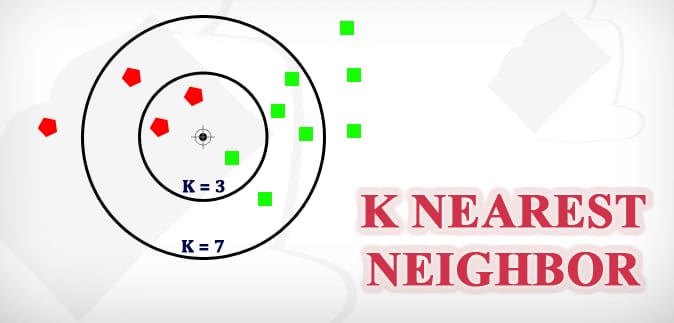What is K-Nearest Neighbor Algorithm (KNN)
What is K-Nearest Neighbor Algorithm?
K-Nearest Neighbor (KNN) is a supervised machine learning algorithm used for classification and regression. In a KNN model, the output for a new data point is based on the “K” nearest data points in the training data set.
Demystifying the K-Nearest Neighbor (K-NN) Algorithm
In the realm of machine learning and data science, the K-Nearest Neighbor (K-NN) algorithm stands as a simple yet powerful technique for classification and regression tasks. Its intuitive concept, flexibility, and ease of implementation make it a fundamental tool in any data scientist’s toolkit. In this blog post, we will explore the principles behind the K-NN algorithm, its applications, strengths, weaknesses, and practical considerations.
Understanding the K-Nearest Neighbor Algorithm
At its core, the K-Nearest Neighbor algorithm is a non-parametric, instance-based machine learning algorithm used for both classification and regression tasks. The primary idea behind K-NN is to predict the class or value of a data point based on the majority class or average value of its K nearest neighbors in the feature space.
Key Components of K-NN:
- Dataset: K-NN relies on a labeled dataset, which means that each data point is associated with a known class label (for classification) or a target value (for regression).
- Distance Metric: To determine the proximity of data points, a distance metric is used, most commonly the Euclidean distance in a multidimensional feature space. Other distance metrics like Manhattan or Minkowski distance can also be employed depending on the problem.
- K-Value: K represents the number of nearest neighbors that the algorithm considers when making a prediction. The choice of K is crucial and should be determined through experimentation.
How the K-NN Algorithm Works
- Initialization: Begin by selecting a value for K and a distance metric.
- Prediction: For a given data point (the one you want to classify or predict), calculate the distance between it and all other data points in the dataset using the chosen distance metric.
- Nearest Neighbors: Select the K data points with the smallest distances to the target data point. These are the “nearest neighbors.”
- Majority Vote (Classification): If you are using K-NN for classification, let the class labels of the K nearest neighbors “vote.” The class that appears the most among these neighbors becomes the predicted class for the target data point.
- Average (Regression): If K-NN is used for regression, calculate the average of the target values of the K nearest neighbors. This average becomes the predicted value for the target data point.
Applications of K-NN
K-NN is a versatile algorithm with various practical applications:
- Image Classification: In computer vision, K-NN can be used to classify images based on their features or pixel values.
- Recommendation Systems: K-NN powers collaborative filtering in recommendation systems by finding users with similar preferences and recommending items liked by their nearest neighbors.
- Anomaly Detection: K-NN can identify anomalies or outliers in datasets by flagging data points that have dissimilar neighbors.
- Medical Diagnosis: In healthcare, K-NN can help predict disease outcomes or diagnose conditions by analyzing patient data and finding similar cases from historical records.
- Natural Language Processing: In text classification tasks, such as sentiment analysis, K-NN can classify documents based on their word vectors.
Strengths of K-NN
- Simple Concept: K-NN’s simplicity makes it easy to understand and implement, making it an excellent choice for beginners in machine learning.
- No Training Required: K-NN is non-parametric, meaning it doesn’t require a training phase. The model directly uses the training data for predictions.
- Flexibility: K-NN can be used for both classification and regression tasks, making it adaptable to various types of problems.
- Interpretability: The algorithm’s predictions are interpretable, as they are based on the actual data points in the dataset.
- Robustness: K-NN can handle noisy data and doesn’t make strong assumptions about the underlying data distribution.
Weaknesses and Considerations
While K-NN has its merits, it also has some limitations and considerations:
- Computational Complexity: As the dataset grows, the computation of distances to all data points can become computationally expensive.
- Choice of K: The choice of the K value is crucial and can significantly impact the model’s performance. Selecting an inappropriate K can lead to underfitting or overfitting.
- Sensitive to Noise: K-NN is sensitive to noisy data and outliers, which can influence the results significantly.
- Curse of Dimensionality: K-NN’s performance can deteriorate as the dimensionality of the feature space increases. High-dimensional spaces make it difficult to find meaningful nearest neighbors.
- Imbalanced Data: In classification tasks with imbalanced class distributions, K-NN may favor the majority class, leading to biased predictions.
The K-Nearest Neighbor (K-NN) algorithm is a straightforward yet powerful tool in the realm of machine learning and data science. Its simplicity, flexibility, and interpretability make it a valuable addition to the data scientist’s toolkit. By understanding the fundamental principles of K-NN, choosing the appropriate K value, and handling its limitations, practitioners can harness its potential for a wide range of applications, from image classification and recommendation systems to anomaly detection and medical diagnosis.
In the ever-expanding landscape of machine learning algorithms, K-NN serves as a reminder that sometimes the simplest methods can yield impressive results, especially when used judiciously and in the right context. Whether you’re just starting your journey in machine learning or are a seasoned practitioner, K-NN remains a valuable and versatile technique worth exploring and mastering.
